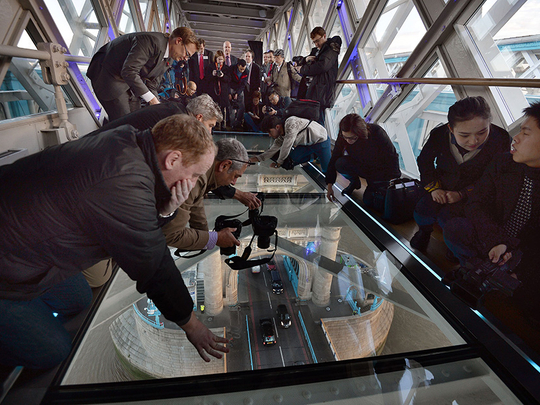
London: “You can walk on the glass,” an official insisted as about 50 of the first visitors went to great lengths to not put two feet on the latest addition to one of the world’s most recognisable and famous bridges.
Tower Bridge unveiled the first of two glass floors along its high-level walkways on Monday, enabling people to look down at the brown, sludgy Thames, the boats that pass along it and the estimated 40,000 people who walk, cycle and drive over the bridge every day.
At 42 metres above the river, it is a terrific, fascinating view, although perhaps not for the faint-hearted.
“There is that sense of trepidation,” said Chris Earlie, head of the Tower Bridge Exhibition.
“It is more exciting I think because you are not actually that high, you can see everything in detail beneath you. I do a lot of climbing and adventure sports but, even for me, the first time was a bit difficult.”
‘Wow project’
The ₤1m (Dh5.8 million) project has seen the installation of glass panels measuring 11-metre long and 1.8-metre wide along the two high-level walkways of the bridge. Each walkway has six glass panels each weighing about 530kg, representing the biggest change to the exhibition since it opened to the public in 1982.
The glass floor scheme has been known internally as the “wow project”, and as well as making sure there is not the slightest chance of the glass cracking, engineers have had to think about making it anti-slip and easily reversible should future generations take against it.
Specially placed lighting will also ensure all modesty is protected. Earlie said one primary objective was making “it look as real as possible ... a big gaping hole in the floor”. The project, two years in the planning, has been funded by the City of London Corporation and the charitable Bridge House Estates.
About 600,000 people a year visit the Tower Bridge Exhibition, generating money that goes to city charities. The best time for people to visit is during one of the 850 times a year that the bridge is lifted.
Earlie said walking on the glass floor was intended to be fun.
“We did a lot of consulting with the public, we don’t want to scare people off — we are not a scare attraction. We are trying to provide something which has never before been seen here before.”












